Search results for 'Murachs MySQL My Guitar Shop Database Chapter 17'
-
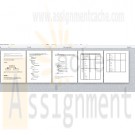
CMIS 102 Assignment 2 build a state-of-the-art gaming computer
$12.00CMIS 102 Assignment 2 build a state-of-the-art gaming computer
Design a program to perform the following task:
Calculate the total price to purchase all the components required to build a state-of-the-art gaming computer from components available on the internet.[Hints: Before attempting this exercise, be sure you have completed all of chapter 3 and course module readings, participated in the weekly conferences, and thoroughly understand the examples throughout the chapter. As before, there are 3 main components of your submission including the problem analysis, program design and documentation, and sample test data.]
Part 1: Analysis [5 points]
Using a similar approach as example 3.6 (textbook page 146): “A new Car Price Calculator”, provide your analysis for the following problem statement: You need to write a program that will calculate the total price to purchase all the components required to build a state-of-the-art gaming computer from newegg.com. You will need to conduct some analysis on newegg.com (or amazon.com) regarding the possible options and prices to be considered. However; assume the computer will consist of the following components:CPU
Case
Power supply
Motherboard
Hard Drive
RAM
DVD
Sound Card
Monitor
Graphics Card
Operating SystemI would recommend you keep the option choices limited to 3 different components, or your program will really grow fast. For example, you could provide options for the Operating System (Windows 7, Red Hat Linux), the RAM (4 MB, 8 MB, 12 MB) and the Hard Drive Size (500 GB, 1 TB, 1.5 TB) and leave everything else as a baseline. I leave it up to you to determine which components you want to add options for and for researching the approximate prices. Be sure your prices are fairly realistic.
Your analysis should be clearly written and demonstrate your thought process and steps used to analyze the problem. Be sure to include what is the required output? What is the necessary input and how you will obtain the required output from the given input? Also, include your variable names and definitions. Be sure to describe the necessary formulas and sample calculations that might be needed.Part 2: Design [5 points]
Using a similar approach as example 3.6 (textbook page 146): “A new Car Price Calculator”, provide your program design for the program you analyzed for calculating the total price of your gaming computer. Be sure to describe the fundamental tasks (i.e., things your program must do) needed to solve the problem so you can use a modular design. Provide pseudocode of your overall design that includes the Main module and the order of the module calls (see page 148 for an example) and a Hierarchy chart for the computer price calculator (see figure 3.8 page 148). Finally, list all of your pseudocode for each module. (See pages148-150 as an example.)Include header and step comments in your pseudocode, using a similar approach as the example provided in section 2.3 (textbook page 86). See example 2.8 on pages 87-88).
Part 3: Test Data [3 points]
Learn More
Prepare at least 5 sets of input data (Test data) along with their expected output for testing your program. Your test data can be presented in the form of a table as was shown in Assignment 1. Be sure that you provide expected output for each test case. -
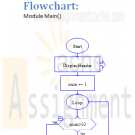
CMIS 102 Assignment 3 Repetition Statements multiplication table
$12.00CMIS 102 Assignment 3 Repetition Statements multiplication table
Write a program that would calculate and display the results for the multiplication table for values ranging from 1 to 100.
Before attempting this exercise, be sure you have completed all of chapter 4, 5 and course module readings, participated in the weekly conferences, and thoroughly understand the examples throughout the chapter. There are 3 main components of your submission including the problem analysis, program design and documentation, and sample test data.
1. Provide your analysis for the following problem statement: You need to write a program that would calculate the results for the multiplication table up from 1 to 100. (For example, 1X1, 1X2, 1X3 ... 1X10, 2X1, 2X2 ... 10X2 ... 10x10). Your program should print the output for each step and output a new line after 10 items. So the example output would be something like this Notice a new line appears after 10 steps:
1 2 3 4 5 6 7 8 9 10
2 4 6 8 10 ... 20
...
10 20 30 ... 100To write the new lines you can just use code similar to : write “new line”. Hint: You will probably use a nested repetition loop.
Your analysis should be clearly written and demonstrate your thought process and steps used to analyze the problem. Be sure to include what is the required output? What is the necessary input and how you will obtain the required output from the given input? Also, include your variable names and definitions. Be sure to describe any necessary formulas and sample calculations.
2. Provide your program design for the program you analyzed for printing the multiplication table. Be sure to describe the fundamental tasks (i.e., things your program must do) needed to solve the problem so you can use a modular design. Provide pseudocode of your overall design that includes the Main module and the order of the module calls, and a Hierarchy chart for the program (see figure 3.8 page 148). Finally, display the flow charts (using Raptor, or your favorite graphics editor) for each module. (See figure 5.3 page 233 as an example.)
Include header and step comments in your pseudocode, using a similar approach as the example provided in section 2.3 (textbook page 86). See example 2.8 on pages 88).
3. Prepare any input data (Test data) along with expected output for testing your program (Note: Programs may not always have both input and output data. Just provide test cases for your application). Your test data can be presented in the form of a table as was shown in Assignment 1.
Learn More -
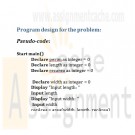
CMIS 102 Assignment 4 Functions Calculate Perimeter of a Rectangle
$12.00Assignment 4 Functions Calculate Perimeter of a Rectangle
In this assignment, you will design a program to perform the following task:
Write a program, using functions, that calculates the area and perimeter of a rectangle whose dimensions (length and width) are provided by a user.Before attempting this exercise, be sure you have completed all of chapter 8 and course module readings, participated in the weekly conferences, and thoroughly understand the examples throughout the chapter. There are three main components of your submission, including the problem analysis, program design and documentation, and sample test data.
1. Provide your analysis for the following problem statement: You need to write a program that calculates the area and perimeter of a rectangle whose dimensions (length and width) are provided by a user.
Your analysis should be clearly written and demonstrate your thought process and steps used to analyze the problem. Be sure to include what the required output is. What is the necessary input and how will you obtain the required output from the given input? Also, include your variable names and definitions. Be sure to describe any necessary formulas and sample calculations.2. Provide your program design for the problem you analyzed for calculating and displaying the area and perimeter of a rectangle. Always work for modular design when possible. Be sure to use separate functions for calculating the area and perimeter of the rectangle. Other subprograms for Input and Output should be included as needed. Be sure to describe the fundamental tasks (i.e., things your program must do) needed to solve the problem so you can use a modular design. Provide pseudocode of your overall design that includes the Main module and the order of the module calls, and a Hierarchy chart for the program (see figure 3.8, page 148). Finally, display the flowcharts (using Raptor, or your favorite graphics editor) for each module. (See figure 5.3, page 225 as an example.)
Include header and step comments in your pseudocode, using a similar approach as the example provided in section 2.3 (textbook page 86). (See example 2.8 on pages 87–88.)
3. Prepare at least three sets of input data (Test data) along with expected output for testing your program. Your test data can be presented in the form of a table as was shown in Assignment 1.
Learn More -
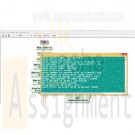
Assignment 2 Frans Virtual Fruit Stand Part 2
$12.00Assignment 2 Fran’s Virtual Fruit Stand, Part 2
Use the concepts and scenario from Assignment 1 to help Fran’s Virtual Fruit Stand increase the functionality of its online shopping cart. When a customer checks out, the shopping cart must store the required data pertaining to each item the customer is buying. Your job is to design a program that will prompt the user for the required data and then store it. The required data includes the item name, the price per pound, and the number of pounds of that item being purchased. When complete, your program should include three (3) arrays, two (2) loops, one (1) and / or conditional statement, and one (1) variable.
Using Visual Logic, design a flowchart that is also a fully functional program to add functionality to the online shopping cart. According to your design, the program must:
Continually accept data regarding the purchase of fruit as specified below until the user enters a sentinel value, or until five (5) items are entered, whichever comes first.
Prompt the user for each item and accept the name of the fruit (e.g., “dried apples”), the price per pound, and the number of pounds sold in a month.
Store the required data in three (3) arrays (e.g., one (1) for the item name, one (1) for the price per pound, and one (1) for the number of pounds being purchased) with corresponding index values. Note: For example, index value 3, when applied to the “itemName” array, would give us the name of the third item that the customer is buying. That same index value of 3, when applied to the “pricePerPound” array, would give us the price per pound of that same third item that the customer is buying.
Store up to five (5) values in each of the three (3) arrays.
Provide functionality in which the user ends the program by typing a sentinel value, and the program tells the user what the sentinel value is. Note: An acceptable message may read “Type n to end the program.”, where “n” is the sentinel value. If the user does not end the program in this way, then the program ends when it has collected the data for five (5) items.
Print an itemized receipt with the following data after the last item in the purchase has been saved to the array.
Item name
Price per pound of each item
Number of pounds purchased of each item
Subtotal price for each item, calculated as price per pound multiplied by the number of pounds
Total weight of the entire order (in pounds)
The cost of shipping which is based on the total weight of the entire order, calculated as 50 cents per pound. Note: For example, if the entire order weighs seven (7) pounds, the cost of shipping would be $3.50.
Grand total price of all items and shipping.Note: Use the “console” option in the output command to accomplish this task. An example of an acceptable output has been provided below:
Learn More -
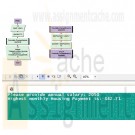
Programming Logic and Design Eight Edition Chapter 9 Exercise 4
Regular Price: $12.00
Special Price $10.00
Programming Logic and Design Eight Edition Chapter 9 Exercise 4
Create the logic for a program that accepts an annual salary as input. Pass the salary to a method that calculates the highest monthly housing payment the user can afford, assuming that the year's total payment is no more than 25 percent of the annual salary.
Learn More -
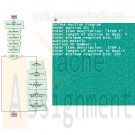
Programming Logic and Design Eight Edition Chapter 4 Exercise 5 A
Regular Price: $12.00
Special Price $10.00
Programming Logic and Design Eight Edition Chapter 4 Exercise 5 A
ShoppingBay is an online auction service that requires several reports. Data for each item up for auction includes ID number, item description, length of auction in days, and minimum required bid. Design for the following:
a. A program that accepts data for one auctioned item. Display data for an auction only if the minimum required bid is over $100.00.
Learn More -
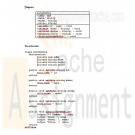
Programming Logic and Design Eight Edition Chapter 10 Exercise 4 Automobile Class
Regular Price: $10.00
Special Price $8.00
Programming Logic and Design Eight Edition Chapter 10 Exercise 4 Automobile Class
Design a class named Automobile that holds the vehicle identification number, make, model, and color of an automobile. Include methods to set the values for each data field, and include a method that displays all the values for each field. Create the class diagram and write the pseudocode that defines the class.
Learn More



